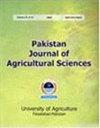气候变化对棉花产量的影响——巴基斯坦的实证调查
IF 0.6
4区 农林科学
Q3 AGRICULTURE, MULTIDISCIPLINARY
引用次数: 0
摘要
巴基斯坦是棉花的主要生产国,棉花是世界范围内不可或缺的作物。农业部门取决于气候,可能容易受到未来气候变化的影响,如气温升高、暴雨、干旱和洪水等直接影响棉花产量的气候变化。本文对气候变化变量和非气候变化变量对巴基斯坦棉花生产力的影响进行了实证研究。采用计量经济学方法“自回归分布滞后模型”(ARDL)对1970 - 2018年的时间序列数据进行分析,探讨变量间关系的存在性和性质。研究结果表明,变量之间存在协整关系,证实了变量之间的长期关系。同时,实证结果表明,温度和降雨量的增加对棉花产量有正向影响。然而,二氧化碳会损害棉花的产量。此外,基础设施的变化对棉花生产力的长期和短期影响都是积极的,而劳动力对生产力的影响是负相关的。面积、肥料用量和种子用量对棉花产量有显著的正向影响。我们采用动态普通最小二乘(OLS)、协整回归估计和序列检验来验证研究结果的稳健性。本研究的发现敦促决策者制定综合政策,以减轻气候变化的不利影响,并加强节约用水。此外,必须采用环境友好的生产投入和现代技术,这有助于获得可持续的棉花生产力。综上所述,棉花作物受区域气候变化的影响显著。虽然本研究分析的是巴基斯坦的案例,但该模型可以推广到所有的发展中国家本文章由计算机程序翻译,如有差异,请以英文原文为准。
The effect of climate change on cotton productivity - an empirical investigation in Pakistan
Pakistan is the primary producer of cotton, which is an indispensable crop worldwide. The agriculture sector depends on the climate and may be susceptible to future climate changes, such as increasing temperature, heavy rainfall, droughts, and floods directly impacting cotton productivity. This study empirically investigates the relationship between climate change variables and non-climate change variables on cotton productivity in Pakistan. An econometric technique, the “autoregressive distributed lag model” (ARDL), was employed on time series data from 1970 to 2018 to explore the existence and nature of the relationship among variables. The findings indicated the presence of co-integration among variables which confirms the long-run relationship among the variables. At the same time, the empirical results revealed that increases in temperature and rainfall positively affected cotton productivity. However, CO2 harms cotton productivity. Moreover, infrastructural changes positively affect cotton productivity in both the long and short run, while labor is negatively related to productivity. The area, fertilizer, and seed consumption showed a significant positive effect on cotton productivity. We employed the dynamic ordinary least squares (OLS), co-integration regression estimation, and the series test to validate the robustness of the finding. The finding of this study urges policymakers to devise a comprehensive policy to mitigate the adverse effect of climate change and upsurge water conservation. Furthermore, it is imperative to adopt environmentally friendly production inputs and modern techniques, which helps to gain sustainable cotton productivity. To conclude, the cotton crop is significantly affected by climate change subject to the region. Although this study analyzed the Pakistan case, the model can be generalized to all the developing countries
求助全文
通过发布文献求助,成功后即可免费获取论文全文。
去求助
来源期刊

Pakistan Journal of Agricultural Sciences
AGRICULTURE, MULTIDISCIPLINARY-
CiteScore
1.80
自引率
25.00%
发文量
18
审稿时长
6-12 weeks
期刊介绍:
Pakistan Journal of Agricultural Sciences is published in English four times a year. The journal publishes original articles on all aspects of agriculture and allied fields.
 求助内容:
求助内容: 应助结果提醒方式:
应助结果提醒方式:


